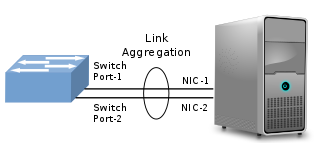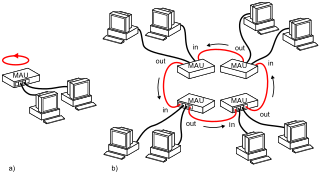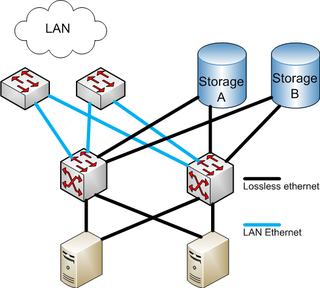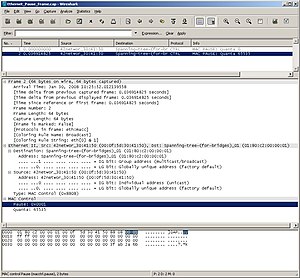
Ethernet is a family of wired computer networking technologies commonly used in local area networks (LAN), metropolitan area networks (MAN) and wide area networks (WAN). It was commercially introduced in 1980 and first standardized in 1983 as IEEE 802.3. Ethernet has since been refined to support higher bit rates, a greater number of nodes, and longer link distances, but retains much backward compatibility. Over time, Ethernet has largely replaced competing wired LAN technologies such as Token Ring, FDDI and ARCNET.
IEEE 802.2 is the original name of the ISO/IEC 8802-2 standard which defines logical link control (LLC) as the upper portion of the data link layer of the OSI Model. The original standard developed by the Institute of Electrical and Electronics Engineers (IEEE) in collaboration with the American National Standards Institute (ANSI) was adopted by the International Organization for Standardization (ISO) in 1998, but it remains an integral part of the family of IEEE 802 standards for local and metropolitan networks.
The Spanning Tree Protocol (STP) is a network protocol that builds a loop-free logical topology for Ethernet networks. The basic function of STP is to prevent bridge loops and the broadcast radiation that results from them. Spanning tree also allows a network design to include backup links providing fault tolerance if an active link fails.
IEEE 802.1 is a working group of the IEEE 802 project of the IEEE Standards Association.

In IEEE 802 LAN/MAN standards, the medium access control (MAC), also called media access control, is the layer that controls the hardware responsible for interaction with the wired or wireless transmission medium. The MAC sublayer and the logical link control (LLC) sublayer together make up the data link layer. The LLC provides flow control and multiplexing for the logical link, while the MAC provides flow control and multiplexing for the transmission medium.
IEEE 802.1Q, often referred to as Dot1q, is the networking standard that supports virtual local area networking (VLANs) on an IEEE 802.3 Ethernet network. The standard defines a system of VLAN tagging for Ethernet frames and the accompanying procedures to be used by bridges and switches in handling such frames. The standard also contains provisions for a quality-of-service prioritization scheme commonly known as IEEE 802.1p and defines the Generic Attribute Registration Protocol.

In computer networking, link aggregation is the combining of multiple network connections in parallel by any of several methods. Link aggregation increases total throughput beyond what a single connection could sustain, and provides redundancy where all but one of the physical links may fail without losing connectivity. A link aggregation group (LAG) is the combined collection of physical ports.
IEEE 802.11w-2009 is an approved amendment to the IEEE 802.11 standard to increase the security of its management frames.
IEEE 802.1ag is an amendment to the IEEE 802.1Q networking standard which introduces Connectivity Fault Management (CFM). This defines protocols and practices for the operations, administration, and maintenance (OAM) of paths through 802.1 bridges and local area networks (LANs). The final version was approved by the IEEE in 2007.
The Link Layer Discovery Protocol (LLDP) is a vendor-neutral link layer protocol used by network devices for advertising their identity, capabilities, and neighbors on a local area network based on IEEE 802 technology, principally wired Ethernet. The protocol is formally referred to by the IEEE as Station and Media Access Control Connectivity Discovery specified in IEEE 802.1AB with additional support in IEEE 802.3 section 6 clause 79.
IEEE P802.1p was a task group active from 1995 to 1998, responsible for adding traffic class expediting and dynamic multicast filtering to the IEEE 802.1D standard. The task group developed a mechanism for implementing quality of service (QoS) at the media access control (MAC) level. Although this technique is commonly referred to as IEEE 802.1p, the group's work with the new priority classes and Generic Attribute Registration Protocol (GARP) was not published separately but was incorporated into a major revision of the standard, IEEE 802.1D-1998, which subsequently was incorporated into IEEE 802.1Q-2014 standard. The work also required a short amendment extending the frame size of the Ethernet standard by four bytes which was published as IEEE 802.3ac in 1998.

Token Ring is a physical and data link layer computer networking technology used to build local area networks. It was introduced by IBM in 1984, and standardized in 1989 as IEEE 802.5. It uses a special three-byte frame called a token that is passed around a logical ring of workstations or servers. This token passing is a channel access method providing fair access for all stations, and eliminating the collisions of contention-based access methods.
Carrier Ethernet is a marketing term for extensions to Ethernet for communications service providers that utilize Ethernet technology in their networks.
Stream Reservation Protocol (SRP) is an enhancement to Ethernet that implements admission control. In September 2010 SRP was standardized as IEEE 802.1Qat which has subsequently been incorporated into IEEE 802.1Q-2011. SRP defines the concept of streams at layer 2 of the OSI model. Also provided is a mechanism for end-to-end management of the streams' resources, to guarantee quality of service (QoS).

Fibre Channel over Ethernet (FCoE) is a computer network technology that encapsulates Fibre Channel frames over Ethernet networks. This allows Fibre Channel to use 10 Gigabit Ethernet networks while preserving the Fibre Channel protocol. The specification was part of the International Committee for Information Technology Standards T11 FC-BB-5 standard published in 2009. FCoE did not see widespread adoption.
Data center bridging (DCB) is a set of enhancements to the Ethernet local area network communication protocol for use in data center environments, in particular for use with clustering and storage area networks.
IEEE 802.1aq is an amendment to the IEEE 802.1Q networking standard which adds support for Shortest Path Bridging (SPB). This technology is intended to simplify the creation and configuration of Ethernet networks while enabling multipath routing.
TRILL is a networking protocol for optimizing bandwidth and resilience in Ethernet networks, implemented by devices called TRILL switches. TRILL combines techniques from bridging and routing, and is the application of link-state routing to the VLAN-aware customer-bridging problem. Routing bridges (RBridges) are compatible with, and can incrementally replace, previous IEEE 802.1 customer bridges. TRILL Switches are also compatible with IPv4 and IPv6, routers and end systems. They are invisible to current IP routers, and like conventional routers, RBridges terminate the broadcast, unknown-unicast and multicast traffic of DIX Ethernet and the frames of IEEE 802.2 LLC including the bridge protocol data units of the Spanning Tree Protocol.
RDMA over Converged Ethernet (RoCE) is a network protocol which allows remote direct memory access (RDMA) over an Ethernet network. There are multiple RoCE versions. RoCE v1 is an Ethernet link layer protocol and hence allows communication between any two hosts in the same Ethernet broadcast domain. RoCE v2 is an internet layer protocol which means that RoCE v2 packets can be routed. Although the RoCE protocol benefits from the characteristics of a converged Ethernet network, the protocol can also be used on a traditional or non-converged Ethernet network.
Time-Sensitive Networking (TSN) is a set of standards under development by the Time-Sensitive Networking task group of the IEEE 802.1 working group. The TSN task group was formed in November 2012 by renaming the existing Audio Video Bridging Task Group and continuing its work. The name changed as a result of the extension of the working area of the standardization group. The standards define mechanisms for the time-sensitive transmission of data over deterministic Ethernet networks.





